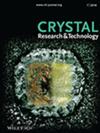Investigation of Phase Transition from Critical Nucleus to Bi2Te3 Nanoplate Based on Screw Dislocation‐Driven Spiral Growth by Solvothermal Synthesis
IF 1.9
4区 材料科学
Q3 CRYSTALLOGRAPHY
引用次数: 2
Abstract
Two‐dimensional bismuth telluride (Bi2Te3) nanoplates have great potential for thermoelectrics and topological insulators. The material performance increases as the nanoplate size decreases. However, the initial stage of the crystal growth of the nanoplates has not been significantly investigated. The Bi2Te3 nanoplates are prepared by solvothermal synthesis and the phase transition based on the screw dislocation‐driven spiral growth of the nanoplates is investigated. The optimal synthesis conditions are first determined by controlling the Te concentration in the precursor solution. The spiral‐grown nanoplates are collected from the synthesized products. The diameter of the critical nucleus is calculated to be in the range of 5.0–7.2 nm from the step width in the spiral. Subsequently, the solvothermal synthesis is implemented by changing the synthesis time from 15 to 1200 min under the optimal conditions of the precursor solution. Crystals are not grown in the solution at 15 min. At 25 min, an intermediate phase of Bi2TeO5 with an approximate grain size of 5.0 nm is formed, which corresponds to the calculated diameter of the critical nucleus. Another intermediate phase of Te is formed, and the Bi2Te3 nanoplates with a lateral size of 300 nm grow slowly at the expense of Bi2TeO5 and Te.基于螺旋位错驱动螺旋生长的临界核到Bi2Te3纳米板相变的溶剂热合成研究
二维碲化铋(Bi2Te3)纳米片在热电和拓扑绝缘体方面具有很大的潜力。纳米板尺寸越小,材料性能越好。然而,纳米片晶体生长的初始阶段还没有得到明显的研究。采用溶剂热合成法制备了Bi2Te3纳米片,并研究了螺旋位错驱动的纳米片的相变过程。首先通过控制前驱体溶液中Te的浓度来确定最佳合成条件。从合成产物中收集螺旋生长的纳米片。从螺旋的阶跃宽度计算出临界核的直径在5.0-7.2 nm之间。随后,在前驱体溶液的最优条件下,将合成时间由15 min改变为1200 min,进行溶剂热合成。15min时,晶体未在溶液中生长。25min时,形成了晶粒尺寸约为5.0 nm的Bi2TeO5中间相,这与计算出的临界核直径相对应。形成Te的另一个中间相,横向尺寸为300 nm的Bi2Te3纳米板生长缓慢,以牺牲Bi2TeO5和Te为代价。
本文章由计算机程序翻译,如有差异,请以英文原文为准。
求助全文
约1分钟内获得全文
求助全文
来源期刊
自引率
6.70%
发文量
121
审稿时长
1.9 months
期刊介绍:
The journal Crystal Research and Technology is a pure online Journal (since 2012).
Crystal Research and Technology is an international journal examining all aspects of research within experimental, industrial, and theoretical crystallography. The journal covers the relevant aspects of
-crystal growth techniques and phenomena (including bulk growth, thin films)
-modern crystalline materials (e.g. smart materials, nanocrystals, quasicrystals, liquid crystals)
-industrial crystallisation
-application of crystals in materials science, electronics, data storage, and optics
-experimental, simulation and theoretical studies of the structural properties of crystals
-crystallographic computing

 求助内容:
求助内容: 应助结果提醒方式:
应助结果提醒方式:


